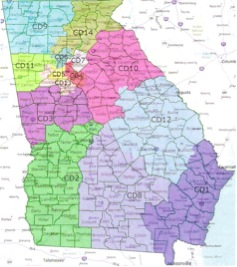By: Kelsey Thomas
In the game of politics, there are always winners and losers. Redistricting – especially when one party will have their first chance in the state’s history to control it – is no exception. After many proposals and amendments, Georgia’s redistricting maps have been signed off on by Governor Deal and are awaiting Department of Justice or D.C. District Court clearance. Although it is certain that Republicans will use their redistricting power in a way that is advantageous to them, the question of who wins and loses doesn’t have a clear answer. So who exactly are the winners and losers? Let’s find out.
Two big winners during redistricting hail from opposite sides of the aisle. Representatives Austin Scott (R, 8th) and Sanford Bishop (D, 2nd) will find themselves entrenched in new party support within their respective districts. Scott, who was elected in 2010 after defeating incumbent Jim Marshall (D), gains ground in South Georgia, where he is most likely to find strong Republican support. In exchange for this strong Republican area, Scott gives Macon in Bibb County, which is strongly Democratic, to Bishop. Although the party in power generally focuses its attention of benefitting itself during redistricting, Republicans seem willing to cede the 2nd District to Bishop in exchange for a more solidly Republican 8th district for their younger incumbent. In fact, by creating a now majority-minority district for Bishop, it seems as though the Republicans are completely giving up on a Bishop challenge after their narrow defeat with Mike Keown in 2010, instead focusing their attention on (shall we say) weaker opponents.
Governor Nathan Deal (R) is one example of a small victor in the redistricting process. Deal, after moving into the Governor’s Mansion, resides in Representative Tom Price’s (R, 6th) district. If you think back to 2010, you might recall Representative Price endorsing Karen Handel, Deal’s chief opponent in the primary race for the governorship. It would appear that Gov. Deal has not taken kindly to this, as the Governor’s Mansion and its surrounding area of Buckhead have been redistricted out of Price’s district and into that of Representative Phil Gingrey (R, 11th). Deal’s victory in not having to be represented by someone who did not endorse him may be small in the grand scheme of things, but it’s probably a big win for Deal’s ego. This also makes Gingrey a redistricting winner, as he can now fundraise in the affluent Buckhead area with the help of the governor . This spells bad news for Tom Price as he loses potentially large campaign contributions.
Politicians are not the only winners and losers. Cities –and more important, citizens – can also end up better or worse off after redistricting. Take, for instance, the segment of Northeast Georgia that makes up the new 9th District. After living in the shadow of Athens and Augusta in the 10th District on the old maps, the northeastern area is now getting its own district that is composed of more homogeneously rural areas and small townships. With Republicans like Martha Zoller and Doug Collins already throwing their hats in the ring, the primary for this open seat is sure to be fierce. Despite a hard primary, the winner of the general election will almost surely be a Republican, adding to the Republican tally with Georgia’s congressional slate.
For every area that moves forward, there’s another that takes a step back. Savannah, divided between the 12th and 1st districts on the old maps, now falls solely into the 1st. While keeping like areas together in the new 9th district was beneficial, Savannah needs as many votes in Congress as it can get. These votes will help Savannah to garner support for federal funding and grants for the deepening of the cities harbor. By putting Savannah completely into one district, the city loses its power in numbers.
Like Savannah, Athens-Clarke County will be at a disadvantage due to its dissection. For years, Democrats in Athens have been a lone island of blue in the sea of red that is northeast Georgia. Now this island is divided into two smaller areas, ready to be diluted amongst the Republican voters in districts 9 and 10. This means that, aside from local officials and state legislatures, it is very unlikely (or simply even more unlikely than before) that the Athens area will be elect a Democrat in the near future. A brief ray of hope for Athens Democrats? Now the music and arts monthly magazine Flagpole will have two congressmen to satirize instead of one.
Now what we have all been waiting for: the biggest loser of Georgia’s redistricting. John Barrow (D, 12th) has served since 2005, and is the last white Democratic congressman serving in the Deep South. After this round of redistricting, it’s pretty clear that Republicans are planning on changing all of that. That strategy has gone so far as to draw Barrow’s home out of the 12th district. In the likely event that Barrow decides to run in the 12th rather than challenge Jack Kingston (R, 1st) in his new home district (but hey, wouldn’t that be exciting if he did?), he’s going to face an uphill battle. With the liberal-leaning Savannah drawn out and replaced by conservative Augusta, this district is certainly advantageous for Republicans. Keeping that in mind, GOP opponents are already lining up, with State Representative Lee Anderson announcing his intent to run in mid-September.
Now that these maps have been approved, Republicans must wait to see if they’ll face a challenge from the Department of Justice while Democrats bite their nails about their members’ re-election prospects. With a little bit of partisan-vote trading, opponent-vote diluting, and threats of litigating, this has been a season of redistricting as usual. Regardless of whom the winners and losers are, one thing is for certain: redistricting has made the 2012 election cycle a fun race to watch.

